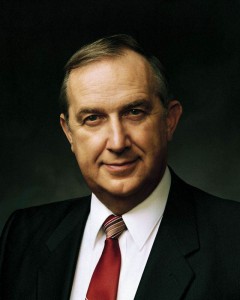Richard Gordon Scott is a member of the Quorum of the Twelve Apostles of The Church of Jesus Christ of Latter-day Saints (often mistakenly called the “Mormon Church”).
Unlike many Mormon apostles, Elder Scott didn’t grow up in a strong Mormon family. His father was not a member of the church, and although his mother was, she didn’t attend. Elder Scott did attend church, at the urging of caring leaders, but not always enthusiastically. This half-hearted attention to religion left him feeling something was missing in every corner of his life.
 He was born in Pocatello, Idaho, but grew up in Washington, D.C. His father was an assistant Secretary of Agriculture under Ezra Taft Benson, who later became a Mormon prophet. Eventually, President Benson would play an important role in his father’s conversion, through his personal example.
He was born in Pocatello, Idaho, but grew up in Washington, D.C. His father was an assistant Secretary of Agriculture under Ezra Taft Benson, who later became a Mormon prophet. Eventually, President Benson would play an important role in his father’s conversion, through his personal example.
Elder Scott wanted to earn his own way to college and spent summers working hard, working on an oyster boat, cutting trees, and repairing railway cars. During these hard-working summers, he began to study the Book of Mormon and gained a real testimony of his religion.
Elder Scott studied mechanical engineering at George Washington University, while playing in a jazz band. In his senior year, he met Jeanene Watkins, the daughter of a senator. When he discovered she refused to marry anyone who had not served a two-year mission for the church, he began to pray to God about this and decided to serve his mission. He was sent to Uruguay, and while he was gone, Jeanene also served a mission in the United States. They were married two weeks after he ended his mission. (Women’s missions are somewhat shorter than men’s, so she returned home first.) At the same time, he was interviewed by Hyman G. Rickover for a secret military job with the Atomic Energy Commission. Rickover seemed to dislike him, making disparaging remarks about his religion, but Elder Scott was determined to keep his Mormon religion in the interview, mentioning his mission, and listing the Book of Mormon as the last book he’d read. Just when Elder Scott was certain he wouldn’t be hired, Captain Rickover admitted he’d been testing Elder Scott, because he needed men with the confidence to stand up for what they believed no matter what. He got the job and worked for this man for twelve years.
When Richard G. Scott was thirty-seven years old, he was asked to serve as a mission president for the LDS Church in Argentina. In this unpaid position, he oversaw the missionary work of a large area for several years. This was an important time in his secular career, but he accepted the call, despite Captain Rickover’s objection. During this time in Argentina, he also worked in Bolivia with the Quechua Indians. Two of his three supervisors in this job went on to become prophets, providing him with amazing training for the future.
At the end of this service, he returned to Washington, D.C. and joined a private consulting firm that focused on nuclear engineering. During this time, his church service increased in responsibility. Eight years after his mission service in Argentina, he was invited to serve in the First Quorum of the Seventy for the Church, a high-level position. He and his family lived in Mexico City for three years of that service, as he was assigned to oversee Mexico and Central America. Elder Scott speaks fluent Spanish.
Another church position he held was Executive Director of the Family History Department. During this time, many changes were made in the church’s genealogy program, including the change of the name from genealogy to family history and the improvements in technology and the use of computers for family history.
The Scotts have known hardship among the joy. They lost two children just six weeks apart, one just prior to birth and the other during heart surgery. They draw on their faith to cope with sorrow. They have five children still living.
Richard G. Scott became an apostle of the Lord in 1988.
Twitter •


 Watch a video about the restoration of the gospel on lds.org
Watch a video about the restoration of the gospel on lds.org